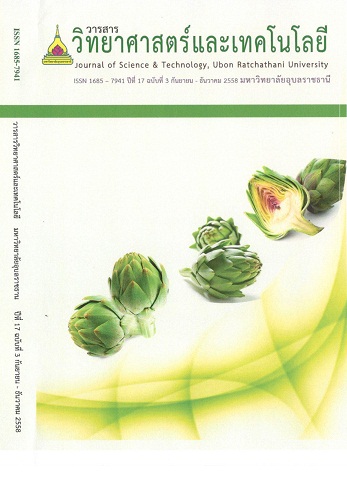Study of Formulation and Production of Okara Chili Paste
Main Article Content
บทคัดย่อ
Okara or soy milk residue is a by-product of the manufacture of soy milk and tofu. Okara contains about 25-27% protein on a dry basis and more than 50% fiber. Nam prik pao is a Thai chili paste that is very popular all over the world. This study substituted okara for shrimp to produce okara nam prik pao chili paste for vegetarians to enhance its nutritional value. The okara was obtained from a tofu factory and roasted prior to use in the formulation of the chili paste. About 10 to 30 grams of the okara was used in the production of the chili paste. By increasing the amount of okara, the textural firmness of the paste increased. The value of lightness (L) and the redness (a) of the paste increased as the amount of the okara increasesd. Sensory assessment indicated that the okara chili paste with 10 grams okara was well-accepted by panelists. Chili paste with 20 grams of okara was further developed by the addition of more water. Tests showed that the addition of water to the okara chili paste improved the texture of the paste. After the addition of 10% more water, the firmness of the chili paste with 20 gram of okara decreased from 398 (gram·force) to 186 (gram·force). The sensory evaluation of the chili paste with 20 grams of okara was completed by a nine point hedonic scale. It was found that the paste received a score of “like moderately." The chemical composition of the okara chili paste was examined. The results showed that the dietary fiber and protein content of the okara chili paste was significantly greater than that of shrimp chili paste (p≤0.05). The dietary fiber and protein content of the okara chili paste were 24.29 and 13.62% on a dry basis respectively, and the dietary fiber and protein content of the shrimp chili paste were 20.25 and 11.98% on a dry basis respectively. Moreover, the okara chili paste was given to 10 vegetarian restaurants in Bangkok to determine their satisfaction with the okara chili paste, and it was found to be significantly acceptable based on the restaurants’ assessments (p≤0.05).
โอคาราเป็นคำในภาษาญี่ปุ่นที่แปลว่า กากถั่วเหลือง ซึ่งเป็นผลผลิตที่ได้จากการทำน้ำเต้าหู้และอุตสาหกรรมเต้าหู้ โอคาราประกอบด้วยสารอาหารจำพวกโปรตีน 25 – 27 เปอร์เซ็นต์ และมีเส้นใยอาหารอยู่มากกว่า 50 เปอร์เซ็นต์ส่วนน้ำพริกเผาก็เป็นน้ำพริกที่มีชื่อเสียงโด่งดังไปทั่วโลก ผู้วิจัยได้เลือกที่จะเปลี่ยนมาใช้ โอคาราแทนการใช้กุ้งในการผลิตน้ำพริกเผาสำหรับผู้ที่รับประทานมังสวิรัติ เพื่อเพิ่มมูลค่าให้กับผลผลิตที่มีสารอาหารที่มีประโยชน์และคุณค่าทางโภชนาการ โอคาราที่ได้มาจากโรงงานอุตสาหกรรมเต้าหู้นั้น ได้ผ่านการคั่วก่อนใช้ โอคาราปริมาณ 10 ถึง 30 กรัม จะใช้ในการทำน้ำพริกเผา หากเพิ่มปริมาณโอคาราก็จะเพิ่มความหนืดให้แก่เนื้อของน้ำพริกเผาด้วย ค่าความสว่าง (L) และค่าสีแดง (a) ของน้ำพริกเผาเพิ่มขึ้นเมื่อใส่โอคาราเพิ่มขึ้น ผลลัพธ์ที่ได้จากการทดลองชิม คือ ผู้ทดสอบให้การยอมรับน้ำพริกเผาโอคาราที่มีส่วนผสมของโอคารา 10 กรัม เป็นอย่างดี น้ำพริกเผาที่ใส่โอคารา 20 กรัม ยังคงทดลองพัฒนาต่อไปด้วยการเพิ่มปริมาณน้า การทดลองแสดงให้เห็นว่าการเพิ่มน้ำลงในน้ำพริกเผาโอคารา ทำให้เนื้อสัมผัสของน้ำพริกเผาดียิ่งขึ้นหลังจากการเพิ่มน้ำเข้าไป 10 เปอร์เซ็นต์ ความแน่นเนื้อของน้ำพริกเผาโอคารา 20 กรัม ก็ลดลงจาก 398 กรัมต่อแรง เป็น 186 กรัมต่อแรง การประเมินรสชาติของน้ำพริกเผาโอคารา 20 กรัม ระดับความชอบปานกลางได้ 9 คะแนน
จากการทดสอบสารประกอบทางเคมี ผลที่ออกมาแสดงให้เห็นว่า น้ำพริกเผาโอคารามีเส้นใยอาหารและโปรตีนมากกว่าน้ำพริกเผาใส่กุ้ง อย่างมีนัยสำคัญที่ระดับความเชื่อมั่น 95 เปอร์เซ็นต์ คุณค่าทางโภชนาการของน้ำพริกเผาโอคาราประกอบด้วยเส้นใยอาหาร 24.29 เปอร์เซ็นต์ และโปรตีน 11.98 เปอร์เซ็นต์ ของน้ำหนักแห้ง ยิ่งไปกว่านั้นได้นำน้ำพริกเผาโอคาราไปให้ผู้ประกอบการธุรกิจอาหารมังสวิรัติ 10 แห่งในกรุงเทพมหานคร ได้ทดลองใช้เพื่อวัดความพึงพอใจ ผลที่ออกมาปรากฏว่า น้ำพริกเผาโอคาราได้รับการยอมรับเป็นอย่างดี อย่างมีนัยสำคัญที่ระดับความเชื่อมั่น 95 เปอร์เซ็นต์
Article Details
บทความที่ได้รับการตีพิมพ์เป็นลิขสิทธิ์ของ วารสารวิทยาศาสตร์และเทคโนโลยี มหาวิทยาลัยอุบลราชธานี
ข้อความที่ปรากฏในบทความแต่ละเรื่องในวารสารวิชาการเล่มนี้เป็นความคิดเห็นส่วนตัวของผู้เขียนแต่ละท่านไม่เกี่ยวข้องกับมหาวิทยาลัยอุบลราชธานี และคณาจารย์ท่านอื่นๆในมหาวิทยาลัยฯ แต่อย่างใด ความรับผิดชอบองค์ประกอบทั้งหมดของบทความแต่ละเรื่องเป็นของผู้เขียนแต่ละท่าน หากมีความผิดพลาดใดๆ ผู้เขียนแต่ละท่านจะรับผิดชอบบทความของตนเองแต่ผู้เดียว


